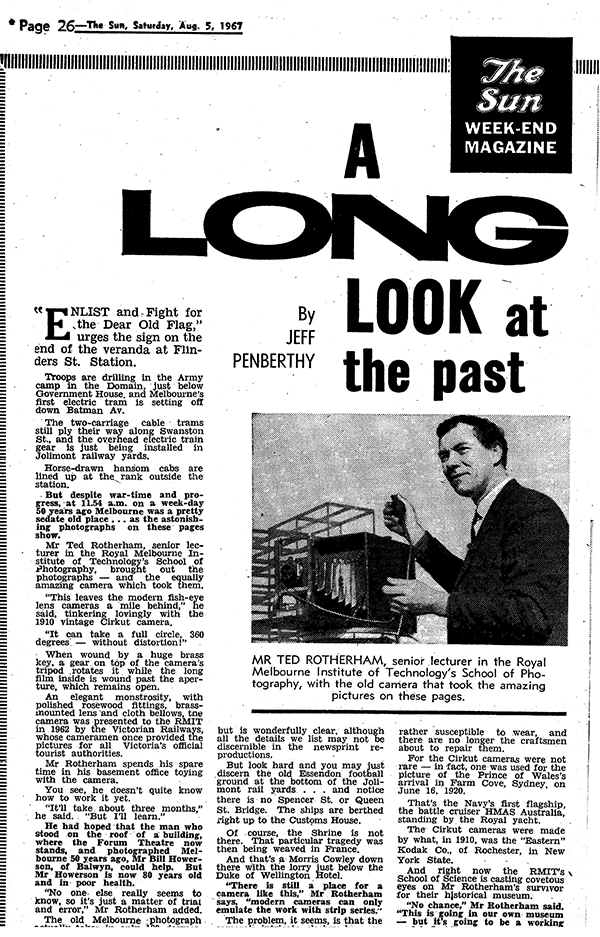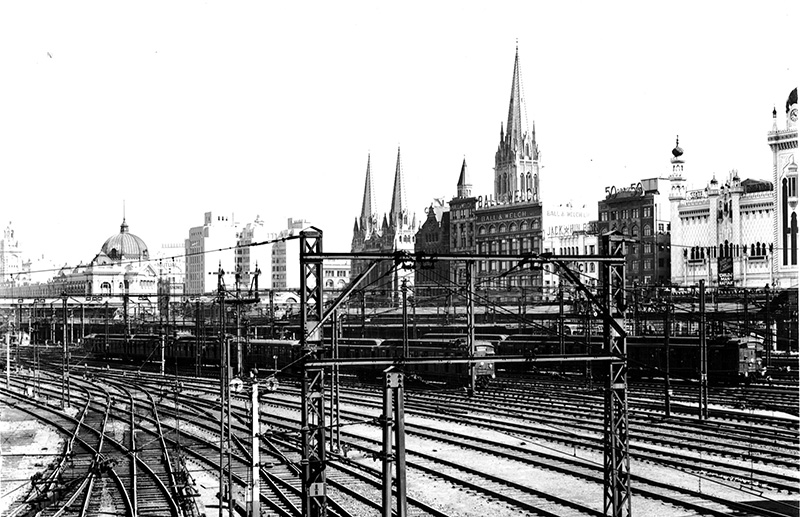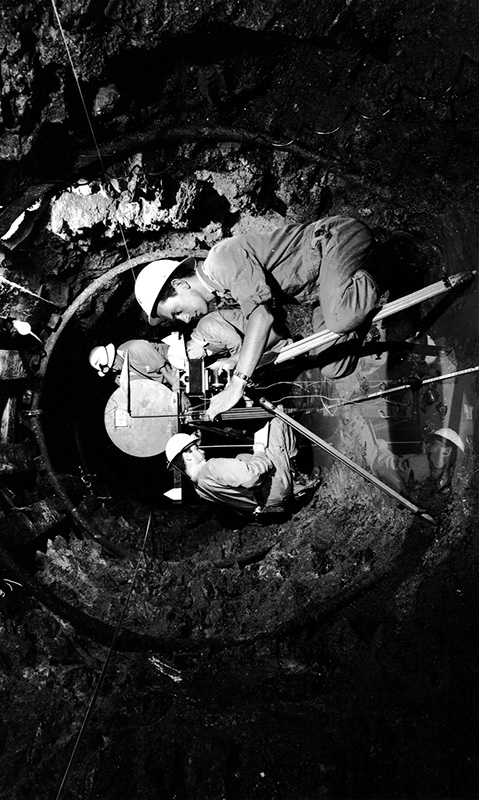PLATFORMS & TRAINS + FLINDERS & JOLIMONT YARDS: STORIES
STUDIO PIE 2012

|
Studio Pie was a 10 week intensive led by London based architect, Michael Corr, involving a cross-section of different level architectural students at RMIT. The Studio was based around the Flinders Street Station International Design Competition and was conducted from July to September 2012. Pie is an architecture, urban design and research practice based in London. Pie values projects with social and cultural relevance, has extensive experience in buildings, working within the public realm, landscape and urban design. Pie regards community and stakeholder engagement as an integral part of the design process – putting people back into architecture. Students first proposed an individual thesis based on aspects of the station precinct at a range of scales and then made propositions based on detailed, analytical research. The students collectively created a 1:30 scale model of the station precinct which was used consistently to analyse the site and determine the scale of the individual projects. Michael engaged the support of researcher and author, Jenny Davies, to provide an historical and social brief for the students’ projects. Davies conducted a site tour of the precinct at the beginning of August which allowed students the opportunity to refine their individual thesis before creating appropriate models. The development of strategic detailing skills was required to translate their propositions into models that could be attached to the scale model of the precinct. A display of the precinct model with the students’ individual models and folios was held at the Emily McPherson Building over the last weekend of the Melbourne Architect Annual, 27 – 28 October, in conjunction with an exhibition by Davies, various public lectures and the launch of her virtual tour website.
|
The Suburban Trains
|
When I first started driving suburban trains in late 1972, they were mostly Red (Tait) trains and Blue (Harris) trains. There were still a few old Dog Box (swing door) trains on the system and the Silver (Hitachi) trains were just entering service. At that time, the suburban system ran, much as it always had since the first electric trains ran back in 1919. No 2&3 platform serviced the Lilydale and Belgrave lines, 4&5 the St Albans, Upfield and Glen Waverly lines and also some through services to Alamein during morning and evening peak. Platforms 6&7 served the Dandenong (with extended services to General Motors at shift changes), Frankston and Williamstown lines. There were also through services to Altona and Newport Workshops at peak times. Platforms 8&9 were for Sandringham and Broadmeadows lines and 10 & 11 the Port Melbourne and St Kilda lines, although only St Kilda trains used platform 11. Platforms 10 & 11 were the only platforms with the signs, “Flinders Street Melbourne” on them, all the rest had only “Flinders Street” signs. This was possibly a hangover from when the Boat Train used to meet the overseas liners at Station Pier and Princes Pier. Some peak hour Frankston services were from platforms 10 & 11 east and Epping and Hurstbridge line trains ran out of the two platforms at Princes Bridge station and in peak times, they also used platform 1 east. Show Grounds trains and Flemington Race Course trains used platform 1 centre and Caulfield and Sandown race specials used 10 & 11 east. Platform 1 west was entirely devoted to parcels traffic. There was an Electric Running (drivers’) Supervisor on duty each day, on platforms 2&3, 6&7 and Princes Bridge from the start of the morning peak until the end of the evening peak. They would also man any of the other platforms is there was some sort problem on a line that platform serviced and were always on the platform when race, show or other special trains were running. During peak times, there were standby drivers on each platform, ready to take over for another driver who was delayed for some reason and stand by trains in each section of Flinders St yard, to replace any defective trains. Train maintenance fitters were located in each section of Flinders St yard and also in a cabin just off the east end of 6&7 platform so that they could attend any defective train on arrival and decide if the fault could be rectified within five minutes or if the train was to be shunted out of service and replaced by a standby train. These were but a few strategies that used to be used to keep the suburban service running on time. The indicator cabin, which was located in the centre of each platform above the Degrave St subway, was the local control point on each platform. The platform supervisor was in constant contact with the Metropolitan train controller and if nessersary could alter the destination of any train at the platform, due to late running or some mishap on the line that the train was timetabled to run on. It was often said by railwaymen and the public alike, that in order to work in an indicator cabin, the employee had to be specially trained in speaking garble, as very few people could understand their announcements. The guards were also supervised from these cabins and stand by guards were located there during peak times. As mentioned earlier, there were still a few Dog Boxes operating in the suburban area in the early 1970’s. These operated as two, four or six car sets on the Pt Melbourne and St Kilda lines, as two or four car sets on the Camberwell to Alamein local service and as a two or five car set on local trains from Newport to Altona and sometimes Williamstown. There were also two seven car sets. One of these came up from Brighton beach to Flinders St each morning, stabled in the west carriage sidings, adjacent to A signal box and returned to Brighton Beach during the evening peak. The other came up from Greensborough each morning to Princes Bridge, stabled all day in PB yard and returned to Greensborough in the evening peak. Between the morning and evening peak hours, trains on most lines ran as four car sets. At the end of the morning peak, trains arriving at Flinders Street that were to remain in service had the three carriages on the East End (known to railwaymen as the unit) detached and shunted to the yard. Between about 3 and 4 in the afternoon, the units would be prepared and reattached. On more than on occasion a red unit would be attempted to be attached to a blue train or a blue unit to a red train. Needless to say, they just didn’t and had to be taken back to the sidings. After the evening peak, many of the lighter trafficked lines ran as two car trains. These were always red trains and were put together as special makeups. The normal make up of a red or blue train was (from the West end) motor, two trailers, motor, making up the block and then two more trailers and a motor. A special makeup was motor, driving trailer, motor, driving trailer, two trailers and a motor. These trains would arrive at Flinders St after the evening peak, the three East end cars ( the unit ) would be shunted to the yard and then the remaining four cars were split into two, two car sets. All suburban trains carried distinctive head signals. By day this was a disc under the driver’s window on the front of the train. By night it was a combination of white lights. By these indicators, the signalmen in the five signal boxes at Flinders St and at the various junctions throughout the suburban area could be sure that they had each train on its correct route. |
The Electric Running Depot
|
The Electric Running Depot (ERD) was located on Batman Ave just west of the old Olympic swimming pool. Originally it was the Jolimont Guards Depot. It was extended at the start of electrification of the suburban network to accommodate drivers as well. The main building consisted of the Superintendent of Electric Running’s office, which he shared with his deputy, the administration office, the lobby, the driver’s sign on clerk and the charge man’s office, the guard’s roster clerk’s office, toilets, driver’s locker room, guard’s locker room, the canteen and the meal room. This room was basically divided in half, the west end for drivers and the east end for guards. I don’t know about the guards’ end but certainly at the drivers’ end, there was further demarcation. The senior drivers’ table was just inside the door from the lobby and was known as the six overcoat table. As we used only be issued with an overcoat every three years, counting the original issue, those who sat on that table had to be drivers of at least fifteen years’ standing and were usually on “A” roster. Woe be tide any junior driver who dared sit at this table even on night shift when no one else was there. Next to that table were the other drivers’ tables and right down toward the guards end was the junior drivers’ and in earlier days loco assistants’ tables. When I first went there as a reliving loco assistant, in 1964 the room was furnished with scrubbed wooden tables with backless wooden benches on either side. It was heated with two large briquette heaters, boiling water was supplied by two gas urns and between these two urns was a large gas hot plate on which meat could be grilled and sandwiches could be toasted underneath. By the time I was a junior driver there in 1972, the briquette heaters had gone but the rest remained the same. Over the years the tables were replaced with laminex ones and the benches with plastic chairs and a microwave oven was added. There was also a veranda with direct access to the meal room. On any day when races were held, Andy the SP bookie sat there taking bets from drivers, guards and any other railway personal who wished to place them. The other part of the ERD was the Lecture Hall. This was commonly referred to as “Bone Head College”. All drivers who transferred to the ERD or outstations of it, spent their first few weeks there learning all the faults that could possibly happen to electric trains and how to rectify them. Also all drivers were rostered to attend lecture hall for one hour, once a month. This was to keep them up to date with any changes that may have come about in the last few weeks. The lecture hall building looked as though it was built well before electrification was planned at the turn of the last century, it looked like a typical marvellous Melbourne building of the 1870 or 80s. I have no idea what it was originally used for. Inside was a class room that could accommodate about twenty to thirty men, a full size working mock up of a Red Train motor carriage, the driver’s cab of a Blue Train and various other electric train equipment. When the Silver Trains first came out, there was talk of installing one similar to the Blue Train but it never happened. The mock ups would have to be the ancestors of the simulators that are now in use at the training centre at South Dynon. The red train mock up was the first electric train driven by any electric train driver. It was also the last electric train to still have a “tin flute” whistle. These were replaced by air horns on all red and dogbox trains in the 1950s. Both the red and blue mock ups were used in the electric train drivers training program for the practical finding and rectification of faults. The class room was furnished with six desks that could each comfortably fit five men seated on wooden benches similar to church pews. There was also a black board on an easel, an instructors table and chair and pictures of electrical circuits and electric train air brake diagrams. When I did my original few weeks in this class room, our instructor, Paul “Dirtybum” Roberts, had a habit of throwing chalk at any man who was not listening. For the first couple of weeks we did nothing except learn the way to get out of any “TRAIN FAILED” situation (Red Trains). A couple of weeks later we learned similar situations with Blue Trains. I can’t say the same for the Silver Trains. When I learnt about them, with two other drivers, the foreman instructing us read out of a book and then told us we knew as much as he did. Between the four of us, we somehow worked out how to get the pantographs up, start the train and later that day, did about half a dozen runs to St Kilda and return. All drivers at the ERD and outstations were trained in silver trains in this way when they first came out. While this training was going on, a fully crewed T class loco was on standby in Flinders St Yard in case of a breakdown. Over Easter 1973, the Jolimont Branch of the Australian Federated Union of Locomotive Enginemen (AFULE) went on strike over the cab design of the D cars on the Silver Trains. It was felt by the members that these cabs were too small and there was no way for the driver to escape in an emergency. To the best of my knowledge, this was the only time that a single branch of the AFULE went on strike, independently of the State Divisional Council. I personally find it odd that the current drivers ever accepted the cab layout of the Siemens trains as to my way of thinking, they look to be just as much of a death trap as the old Silver Train “D” car cabs ever were. When the Comenge trains were first introduced, I remember spending a day or two in the lecture hall, learning about them and at the same time looking over one in the yard, but I cannot recall them being confined to one or two lines while we were leaning them. To the best that I can remember, after learning about them, we all just did our first run on them with an instructor, when it came up on our roster. I was stationed at Carrum at that time and my first run on a Comenge train was from Flinders St to Alamein and return. |
My Time as a VR Publicity Photographer
|
During the 1960s the railways had about twelve people employed at different levels in the railways photographic division:
The Plan Printing Division was also under the Chief Photographer at that time. I started as a Junior and worked up through the ranks and was given the opportunity to do a Diploma of Photography in 1964 -66 at RMIT. I was the youngest person to become the Publicity Photographer at the age of 24 in 1967, the position which I held until I left the railways in 1970. The guy who preceded me as Publicity Photographer was Roger Hayne, since deceased. He left the railways to join the Antarctic Division and did a couple of trips down there before setting up a photographic school in South Melbourne. The guy who followed me in the Publicity Photographers job was John Phillips. He subsequently went on to become the Chief Photographer and I still have regular contact with him and see him from time to time. |





